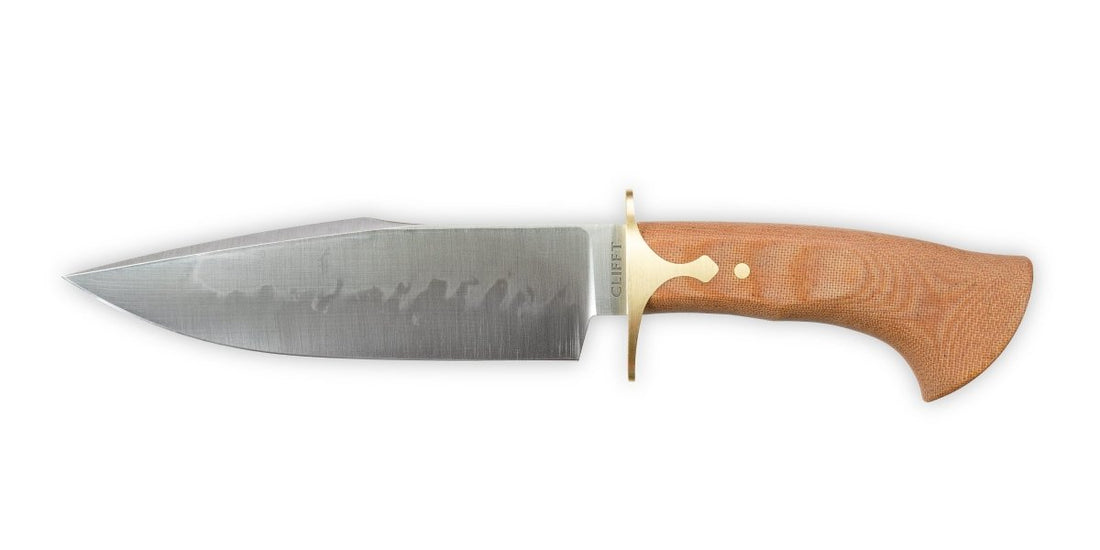In the world of custom and traditional bladesmithing, few features capture the imagination quite like a hamon. The distinctive, wavy line running along the blade’s edge isn’t just for looks—it’s a visual marker of a complex heat treatment process that enhances both performance and aesthetics. While hamons are most commonly associated with Japanese swords, they are also a prized feature in high-end custom knives. However, achieving a proper hamon in a production knife is an immense challenge, making it a rarity in modern factory-made blades.
At Dauntless Manufacturing, we took on that challenge with the Clifft Bowie, which features a striking hamon and won Best American Made in the Factory segment at Blade Show Texas. The Clifft Bowie proves that, while difficult, achieving a high-quality hamon in a factory setting is possible—but only with the right steel, heat treatment, and craftsmanship.
What Is a Hamon?
A hamon is the visible boundary between the hardened edge and the softer spine of a blade, created through a differential heat treatment process. Traditionally, this is done by applying a clay mixture to the blade before quenching it in water or oil. The exposed edge cools rapidly, forming martensite, a hard but brittle steel structure, while the clay-covered spine cools more slowly, retaining a softer, tougher structure called pearlite or bainite.
The result is a blade with excellent edge retention and cutting ability (hardened edge) while maintaining shock resistance and flexibility (softer spine)—a balance that has been perfected in traditional Japanese swords for centuries.
Why Is It Difficult to Achieve in Production Knives?
While a hamon is a prized feature, it is rarely seen in large-scale production knives. The reasons for this are technical, practical, and economic:
1. Complex Heat Treatment Process
Achieving a hamon requires a very controlled clay application, heating, and quenching process. In a production setting, where consistency is key, this adds too many variables that could lead to high failure rates.
2. Limited Steel Suitability
Not all steels can produce a visible or aesthetically pleasing hamon. Many modern steels, like CPM Magnacut or CPM 3V, lack the necessary carbon content and thermal properties to form a distinct hamon.
3. High Risk of Warping or Cracking
The sudden cooling of the edge while the spine cools more slowly creates internal stresses. Traditional water quenching, which enhances hamon visibility, has a high risk of warping or even cracking blades. Production knives are typically oil-quenched to reduce these risks, but this often results in a less pronounced hamon.
4. Additional Labor and Refinement
Even when a hamon is successfully formed, it doesn’t simply appear on its own. The blade must be meticulously polished and etched to bring out the contrast between the hard and soft areas. This step is highly labor-intensive and not feasible for high-production runs.
The Clifft Bowie: A Rare Production Knife with a Hamon
At Blade Show Texas 2025, the Clifft Bowie took home the award for Best American Made in the Factory segment, in part due to its bold, well-defined hamon—a feature almost never seen in factory knives. Scheduled for release on April 4th, 2025, the Clifft Bowie is proof that, with the right approach, a production knife can achieve a beautiful and functional hamon.
This was only possible by carefully selecting the right materials, refining our heat treatment process, and dedicating the necessary time to polishing and finishing each blade. It’s not the easy way, but at Dauntless Manufacturing, we believe in pushing boundaries and delivering knives that stand out both in performance and craftsmanship.
Why 125Cr1 Is an Excellent Steel for Hamons
If you want a steel that produces a bold, active hamon, 125Cr1 (a high-carbon tool steel) is an outstanding choice. Here’s why:
- High Carbon Content (~1.25% C) – This allows for a strong martensitic transformation, making the hamon crisp and well-defined.
- Shallow Hardening – Unlike deep-hardening steels like O1 or D2, 125Cr1 responds exceptionally well to differential hardening, forming dramatic hamons with intricate activity.
- Fine Grain Structure – A properly heat-treated 125Cr1 blade polishes beautifully, enhancing the contrast between the hardened edge and softer spine.
- Takes an Aggressive Edge – While primarily chosen for its hamon potential, 125Cr1 is also an excellent cutting steel when heat-treated correctly.
Conclusion
A well-executed hamon is a testament to a bladesmith’s skill, blending performance with artistry. While it is impractical in large-scale production knives, custom makers and small-batch producers continue to push the boundaries of what’s possible with steels like 125Cr1.
At Dauntless Manufacturing, we took on that challenge with the Clifft Bowie, proving that a factory-made knife can feature a true hamon—if you’re willing to put in the work.
The Clifft Bowie will be released on April 4th, 2025—stay tuned for more details!
Would you like to see more hamon-featured knives in Dauntless Manufacturing’s lineup? Let us know your thoughts in the comments!

